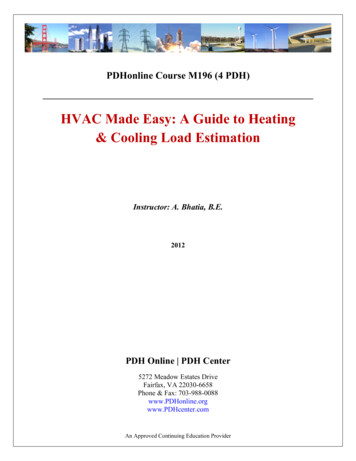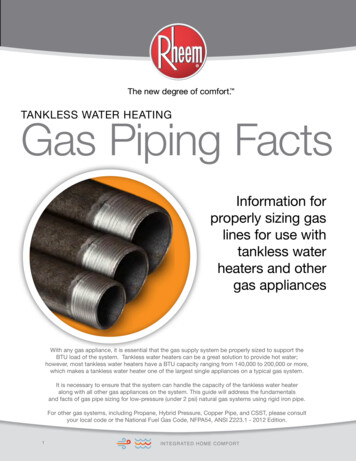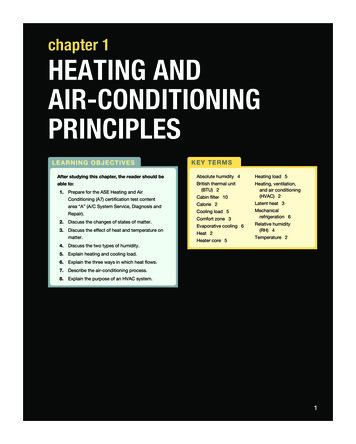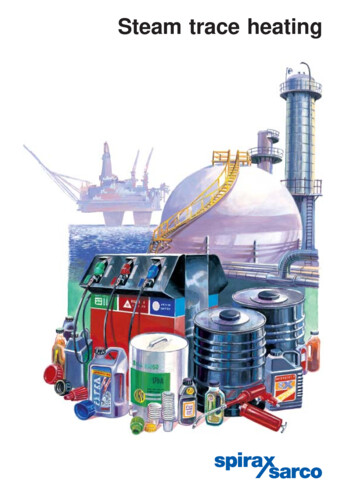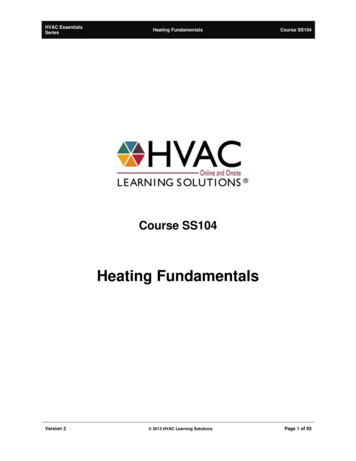
Transcription
CE82Domestic Ground Source HeatPumps: Design and installationof closed-loop systems– A guide for specifiers, theiradvisors and potential users
Contents 1Introduction – systems and applications1.1Types of system1.2Applications1.3Potential benefits33442General design63Ground heat exchanger3.1Types of ground heat exchanger3.2Ground characteristics3.3Sizing3.4Loop depth, spacing and layout3.5Piping material3.6Circulating fluid3.7The ground loop circulating pump3.8Installation and testing7789991010104The heat pump4.1Heat pump sizing4.2Electrical requirements1213135Distribution systems5.1Space heating5.2Domestic water heating5.3Cooling141414156Control strategies6.1Space heating6.2Domestic water heating1616167Costs7.1Capital costs7.2Running costs171717Do’s and don’ts19Further guidance and useful contacts21Domestic Ground Source Heat Pumps: Design and installation of closed-loop systems (2007 edition)
1Introduction – systems and applicationsOur society has become increasingly dependenton fossil fuels such as oil, coal and natural gas.These are finite resources, having been created bynatural processes over millions of years. Burningthem to produce energy results in emissions of‘greenhouse gases’, including carbon dioxide(CO2). These gases trap solar radiation in theearth’s atmosphere and cause undesirablechanges in the climate.to meet the energy efficiency requirements of theCode for Sustainable Homes.Home energy use is responsible for over a quarterof UK CO2 emissions which contribute to climatechange. To help mitigate the effects of climatechange, the Energy Saving Trust has a range oftechnical solutions to help UK housing professionalsbuild to higher levels of energy efficiency.1.1Types of systemA GSHP system consists of three elements;Despite their increasing use elsewhere, GSHPs are arelatively unfamiliar technology in the UK. But theirperformance is now such that, if properly designedand installed, they represent a very carbon-efficientform of space heating. A useful list of do’s anddon’ts can be found on page 19.The purpose of this guide is to give specifiers andadvisors clear and concise information about groundsource heat pumps (GSHPs) in dwellings. It coversthe different types of system, and the benefits,limitations, costs and suitability of the varioustechnologies. It can also help housing professionals1A ground heat exchanger, which collects heatfrom the ground.2A water-to-water or water-to-air heat pump,which raises the heat collected to a usefultemperature and transfers it to the house.3A heat distribution system which providesthe heat to the house for example underfloorheating.Heat ystemExpansionvalveGround heat exchangerFigure 1: A typical GSHP systemDomestic Ground Source Heat Pumps: Design and installation of closed-loop systems (2007 edition)
Initially open-loop GSHP systems using groundwateras the heat source were most widely used. Wherethere is a suitable source of groundwater this can becost effective, because the water can be deliveredand returned using relatively inexpensive wellsrequiring little ground area. However, there are somedisadvantages – water availability is limited, foulingand corrosion may cause problems depending onwater quality and, most importantly, environmentalregulations covering the use of groundwater areincreasingly restrictive.These limitations mean that interest is now focusedon closed-loop or ground-coupled systems, wherethe ground heat exchanger consists of a sealedloop of pipe buried either horizontally or vertically inthe ground. This guide only considers closed-loopsystems as they are more widely applicable thanopen-loop systems.1.3Potential benefitsTo maximise the efficiency of a heat pump whenproviding heating, it is important to not onlyhave a low heating distribution temperature, butalso as high a source temperature as possible.Overall efficiencies for GSHPs are inherentlyhigher than for air source heat pumps, becauseground temperatures are higher than the mean airtemperature in winter and lower in summer. Theground temperature also remains relatively stable,allowing the heat pump to operate close to itsoptimal design point. Air temperatures, however,vary both throughout the day and seasonally, andare lowest at times of peak heating demand. Airhas a lower specific heat capacity than water, so tosupply the same energy more air must be suppliedto the heat pump, which in turn requires moreenergy. For heat pumps using ambient air as thesource, the evaporator coil is also likely to needdefrosting at low temperatures.Two types of closed-loop system are possible:1Direct expansion (DX) – where refrigerant iscirculated directly through the ground loop2Indirect – where a water/antifreeze solutioncirculates through the ground loop and energy istransferred to or from the heat pump refrigerantcircuit via a heat exchanger.GSHPs are most commonly indirect systems.1.2ApplicationsGSHPs can be used to provide space and domesticwater heating and, if required, space cooling toa wide range of building types and sizes. But theprovision of cooling in addition to heating will result inincreased energy consumption however efficiently itis supplied – see ‘Reducing overheating - a designer’sguide’ (CE129) for further guidance. GSHPs areparticularly suitable for new build as the technology ismost efficient when used to supply low temperaturedistribution systems, such as underfloor heating. Theycan also be used for retrofit, especially in conjunctionwith measures to reduce heat demand. GSHPs canbe particularly cost effective in areas where mains gasis not available, or in developments where there is anadvantage to simplifying the infrastructure provided.This guide concentrates on the provision of spaceand water heating to individual dwellings, but thetechnology can also be applied to blocks of flats orgroups of houses. For well-designed GSHP systems, used to supplylow temperature, water-based heating systems(e.g. underfloor heating), seasonal efficiencies ofbetween 300 and 400 per cent are common forindirect systems, and can be higher (350 to 500 percent) for direct expansion systems. By comparisonthe seasonal efficiency of an air source heat pumpsystem is about 250 per cent, although there istechnical potential to increase this. The seasonalefficiency is the ratio of the energy delivered fromthe heat pump to the total energy supplied to it,measured over a year or heating season (includingenergy demands for circulation, e.g. to circulate fluidround the ground heat exchanger).The high seasonal efficiency of GSHP systemsreduces the demand for purchased electricity,and the associated emissions of CO2 and otherpollutants. Figure 2 shows the relationship betweenutilisation efficiency and CO2 emissions for differentdomestic fuels.For example it can be seen that (assuming anaverage CO2 emission factor for electricity of0.422kg/kWh) using a GSHP with a seasonalefficiency of 350 per cent would result in theemission of 0.12kg of CO2 for every kWh of usefulheat provided. By comparison a condensing gasboiler (assuming a CO2 emission factor for gas of0.194kg/kWh), operating at a seasonal efficiency of85 per cent, would result in 0.23kg CO2 for everyDomestic Ground Source Heat Pumps: Design and installation of closed-loop systems (2007 edition)
kWh of useful heat supplied – almost double theCO2 emissions from the GSHP. The emission figurefor electricity is an average for the UK generationmix. If the heat pump was supplied with energyfrom a renewable source, CO2 emissions could besubstantially reduced or eliminated.As well as reducing purchased energy consumptionand CO2 emissions, GSHPs have a number of otherenvironmental and operational advantages: High reliability (few moving parts, no exposure toweather). High security (no visible external components tobe damaged or vandalised). Long life expectancy (typically 20 – 25 years forthe heat pump and over 50 years for the groundcoil). Low noise. Low maintenance costs (no regular servicingrequirements). No boiler or fuel tank. No combustion or explosive gases within thebuilding. No flue or ventilation requirements. No local g/kWh)0.3useful heatdelivered0.20.10050 100 150 200 250 300 350 400 450 500Utilisation efficiency (per cent)Figure 2: CO2 emissions* and fuel use efficiency*Assumed CO2 emission factors (SAP 2005):Electricity 0.422kg/kWh deliveredGas 0.194kg/kWhLPG 0.234kg/kWhOil 0.265kg/kWhDomestic Ground Source Heat Pumps: Design and installation of closed-loop systems (2007 edition)
2General designBefore considering a ground source heat pump, itis important to explore ways of minimising spaceheating and hot water demand by incorporatingenergy efficiency measures. (For possiblemeasures see ‘Domestic energy efficiency primer’(GPG171/CE101)).The most important first step in the design of aGSHP installation is the accurate calculation of thebuilding’s heat loss, its related energy consumptionprofile and the domestic hot water requirements.This will allow accurate sizing of the heat pumpsystem, which is particularly important because thecapital cost of a GSHP system is generally higherthan for conventional systems, and economies ofscale are more limited.Oversizing will significantly increase the installedcost for little operational saving, and will meanthat the period of operation under part load isincreased. Frequent cycling reduces equipmentlife and operating efficiency. If the system isundersized, design conditions may not be met andthe use of top-up heating, usually direct actingelectric heating, will reduce the overall systemefficiency.A GSHP system can be designed to provide all therequired heat (a monovalent system). However,because of the relatively high capital cost, it may beeconomic to consider a bivalent system where theheat pump is designed to cover the base heatingload, while an auxiliary system covers the additionalpeak demand (e.g. if the savings in capital cost offsetany increase in running costs).Reducing the output temperature required fromthe heat pump will increase its performance. The majority of heat pumps have an operatingtemperature limit of 50 C – 55 C in mostapplications. These are not suitable formonovalent operation in combination withtraditionally sized, high temperature wet radiatordistribution systems, or for providing all thedomestic water heating as they will not be ableto raise the water temperature to that required(60 C) to avoid the risk of Legionella. A few heatpumps, however, can provide output temperaturesof up to 65 C.The performance of the heat pump depends on theperformance of the ground loop and vice versa. It istherefore essential to design them together.Closed-loop ground source heat pump systemswill not normally require permissions/authorisationsfrom the Environment Agency (see Useful contactson page 22). However, the Agency can providecomment on proposed schemes with a view toreducing the risk of groundwater pollution orderogation that might result.The main concerns are: The risk of the underground pipes/boreholescreating an undesirable pathway for water toflow between different water bearing strata. Undesirable temperature changes in the aquiferthat may result from the operation of a GSHP. Pollution of groundwater that might occur fromleakage of additive chemicals used in the system.Where there is a risk of, or actual, releases ofpolluting matter to groundwater the agency canserve statutory notices to protect groundwater.Domestic Ground Source Heat Pumps: Design and installation of closed-loop systems (2007 edition)
3Ground heat exchanger3.1Types of ground heat exchangerIndirectIn an indirect circulation system the ground heatexchanger consists of a sealed loop of highdensity polyethylene pipe containing a circulatingfluid (usually a water/antifreeze mixture), whichis pumped round the loop. Energy is transferredindirectly via a heat exchanger to the heat pumprefrigerant. The majority of systems are indirect.DirectAlternatively, the refrigerant can be circulateddirectly through a copper ground heat exchanger.This is called a direct expansion (DX) system. Directcirculation systems are more efficient than indirectsystems because there is good thermal contact withthe ground, the heat exchanger between the groundcoil circulating fluid and the refrigerant is eliminated,and no circulation pump is required. This means that,for a given output, a shorter ground coil is requiredthan for an indirect system, giving an installation costsaving that helps offset the higher material cost, butthese systems require more refrigerant and there is agreater potential risk of refrigerant leaks. DX systemsare most suitable for smaller domestic applications.They are uncommon in the UK.Heat exchangerThe ground heat exchanger is buried eitherhorizontally in a shallow trench (at a depth of1.0m – 2.0m) or vertically in a borehole. The choiceof horizontal or vertical system depends on theland area available, local ground conditions andexcavation costs. As costs for trenching and drillingare generally higher than piping costs, it is importantto maximise the heat extraction per unit length oftrench/borehole.Horizontal collectors require relatively large areas,free from hard rock or large boulders, and aminimum soil depth of 1.5m. They are particularlysuitable in rural areas, where properties are larger,and for new construction. In urban areas theinstallation size may be limited by the land areaavailable. Multiple pipes (up to six, placed eitherside-by-side or in an over/under configuration)can be laid in a single trench, but they should beat least 0.3m apart. The amount of trench requiredcan also be reduced if the pipe is laid as a seriesof overlapping coils (sometimes referred to as aSLINKY , see Figure 3), placed vertically in a narrowFigure 3 Trench and slinky GeoSciencetrench or horizontally at the bottom of a widertren
A ground heat exchanger, which collects heat from the ground. A water-to-water or water-to-air heat pump, which raises the heat collected to a useful temperature and transfers it to the house. A heat distribution system which provides the heat to the house for example underfloor heating. 1 2 3




